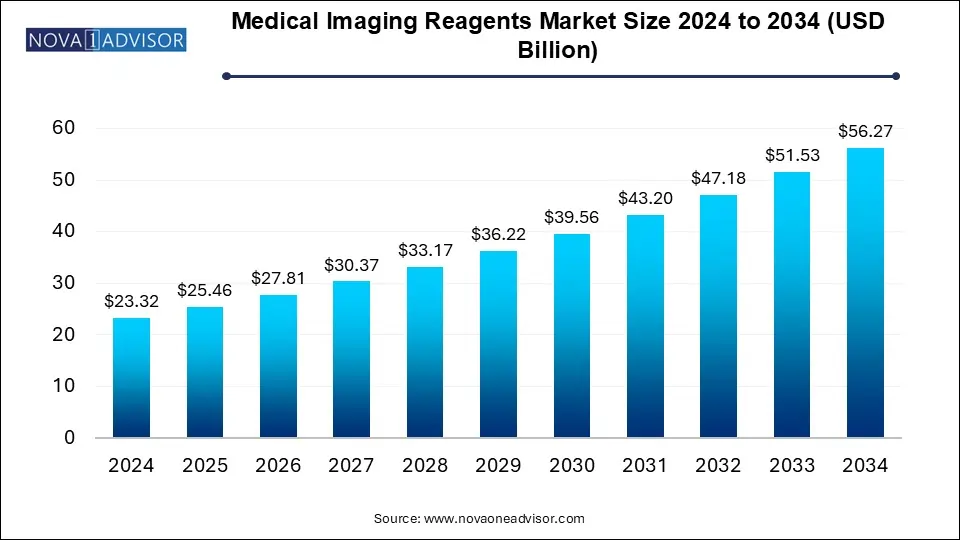The global medical imaging reagents market size was valued at USD 25.46 billion in 2025 and is predicted to be worth USD 56.27 billion by 2034, with a CAGR of 9.21% from 2025 to 2034. The medical imaging reagents market is driven by rising awareness, technological advances, and government initiatives.

The medical imaging reagents market includes activities related to the manufacture, distribution, and use of substances that are specially administered to patients before imaging procedures to enhance the contrast and clarity of diagnostic images. The importance of the medical imaging reagents market lies in enhancing diagnostic excellence and boosting healthcare research. Imaging modalities, such as X-rays, γ-rays, and radioactive particle imaging, are dependent on these reagents, enabling healthcare professionals to perform a precise evaluation of the internal structure and pathology.
Optical imaging and fluorescence-guided surgery (FGS) have been emerging technologies in medicine with considerable opportunities for growth in the medical imaging reagents market. Advancements in surgical precision, early detection of diseases, and reduced complications related to surgery, have considerably been responsible for such growth. They include key growth drivers such as improving the precision of surgery, rising demand for minimally invasive procedures, increasingly expanding applications beyond oncology, and advances in imaging agents. The colored fluorescent dyes introduced into the body for FGS are primarily designed to highlight the isolation of tumor tissues and critical structures and reduce recurrence rates while improving patient outcomes. Research and technology development investments will further boost innovation to make these imaging solutions pivotal in the future generation of surgical care.
A great opportunity in market development opens up AI and machine learning in medical imaging due to their contribution to diagnostic accuracy enhancement, workflow finalization, and lowering healthcare costs. The growth engines for this market involve better efficiency, higher precision, teleradiology expansion, automated diagnostics, and relevant regulatory approvals. AI systems can perform much faster than human radiologists, thus allowing a patient a minimum waiting time and fewer probabilities of false positives. AI-integrated solutions enable remote analysis that extends the boundaries of access to clinical images even to regions with few diagnostic resources. Therefore, emerging market potentials within medical imaging for AI solutions would soon broaden, mainly due to the growing investments in AI healthcare solutions.
Medical imaging reactants, contrast dyes, and radiotracers form the essential ingredients essential to the enhancement of the diagnostic accuracy of MRI, CT, and PET scans. However, a lot of constraining factors, such as high cost, less accessibility, and complex production, storage, and healthcare infrastructure, hinder the deployment of these medical imaging reagents. For example, the demand for PET radiotracers involves immediate production, which adds up to costs. The gadolinium-based contrast agents are also quite costly due to the refining of rare-earth metals and safety studies. Supply chain problems and costly purification of iodinated contrast media increase the health and economic burdens of this technology on low-income patients.
By modality segment, the X-ray segment dominated and is significantly growing due to the increase in road traffic accidents worldwide. X-ray imaging helps in the detection of pathological changes in bone structure, thus, making ample opportunity for growth. The sports-increasing trend is bringing in more patients with injuries, thus giving momentum to the market.
The city scan segment is also growing, owing to a great number of patients riding on these medical imaging procedures. Substantial growth of this sector is attributed to the advanced technology-based medical imaging procedures being utilized by diagnostic centers and hospitals to attract potential consumers.
The class segment, contrast reagents dominated and is expected to witness further growth on account of approvals and the increasing number of diagnostic centers employing these reagents. This market is fairly buoyed by the demand for advanced technologies and better image quality, as contrast reagents promise high-quality images distinguishing the intended area from other artifacts which are crucial for accurate diagnosis and treatment. Other segments such as optical reagents and nuclear agents are also growing in market demand, given their high-quality image value. The ability to produce clear images becomes critical in establishing pathological changes and designing a reliable treatment plan for the patient.
By application Insight, the neurological disorder segment dominated the market due to the increasing number of cases coupled with advanced medical imaging. Neurological disorders are common among the elderly, and advanced imaging techniques help in the confirmation of diagnoses and the determination of suitable treatments. Advanced medical imaging reagents are utilized at diagnostics centers to achieve accurate imaging of underlying pathologies and changes within the body.
North America, being the largest of all medical imaging reagents markets due to advanced healthcare infrastructure, an aging population, and high prevalence and incidences of chronic diseases, is hence an ever-emergent region for imaging in medical diagnostics. The increasing population of elderly people and health awareness add to the market growth, and reimbursement policies help the accessibility of medical imaging procedures. Prominent companies like GE HealthCare and MIM Software are continually shaping the regional market amid strategic acquisitions that enable expanding capabilities in medical imaging analysis and AI-based diagnostics.
The European market for medical imaging reagents will be expanded due to increased awareness of early disease detection and an aging population. Demand for imaging reagents is driven by the increasing number of people suffering from age-related conditions, the development of technology, and the expansion of healthcare services. Other factors that favor the growth of this market include government investments, better reimbursement policies, and increased expenditure on healthcare. All these factors encourage effective procedures for diagnosis and safer medications.
This report forecasts revenue growth at country levels and provides an analysis of the latest industry trends in each of the sub-segments from 2021 to 2034. For this study, Nova one advisor, Inc. has segmented the Medical Imaging Reagents Market
By Modality
By Class
By Application
By Geography